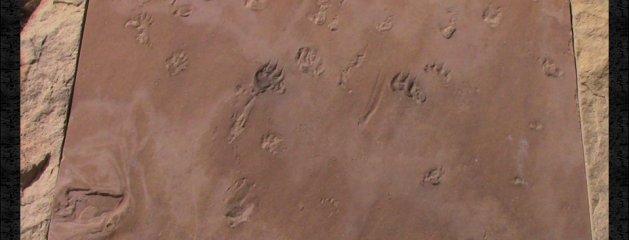In the Fossil Record, there are numerous examples of trackways appearing before the fossils of the animals that made them! If the layers formed slowly over long periods of time (millions of years), why did the tracks form into fossils at times when the hard parts of that creature did not fossilize until later? Maybe a simpler and more reasonable explanation is that these were footprints of creatures fleeing the rising floodwaters that eventually would have inundated...
Read MoreA Moving Mountain!
Mount Mannen in Norway is collapsing! This is puzzling to secular scientists. Notice how our worldview affects the way we view the evidence: “People tend to regard mountains as more or less permanent fixtures, so they are generally surprised when they undergo rapid changes.11 One big factor in this surprise is the way in which the philosophy of uniformitarianism is deeply interwoven into modern culture. Any discussion of geological features always involves the...
Read MoreTracks up to the fossils!

“Animal tracks almost always precede body fossils in the fossil record, as paleontologist Dr Marcus Ross explains (see Reading evolution into the Scriptures and Is Genesis History?): “This is a pattern we see in several different groups, where their footprints are first, and their body parts are later. For the trilobites, for the amphibians, for the dinosaurs—the first time I find evidence of them in the fossil record, it’s from trackways, not from hard parts. From...
Read MoreHow Tall??
According to Wikipedia, the Colorado Plateau rose up 20 million years ago. -Based on 7 in of erosion / 1000 years, in 20 million years, 11,666 ft would erode. The Colorado plateau is currently between 5000-7000 ft elevation. So was the plateau 17,000 ft tall??
Read MoreSignificant Overthrusts!
Around the world, how many examples of large rock segments flipping over do we have? “There are a number of overthrusts around the world where old strata lie on top of younger rocks. In many cases these extend for miles with no evidence of movement at the contact. Native American scholar Vine Deloria comments, This concept has been liberally applied when the fossils do not line up in a coherent evolutionary sequence, even when there has been no evidence that strata...
Read More“There is no evidence for a ‘Young Earth’!” – Or is there?
“There is much powerful and positive evidence for a young earth, including dinosaur soft tissue discovered in dinosaur bones supposedly hundreds of millions of years in age; or the presence of carbon 14 in diamonds, coal, oil and other fossils; or global geological formations that can only be explained by invoking continental scale catastrophic flooding, such as planation surfaces, and water gaps; or the amount of salt in the world’s oceans, etc. For an extensive...
Read MoreCould Noah’s ark have really survived the choppy worldwide floodwaters?
“Various marine engineering studies done on the sea worthiness of Noah’s Ark indicate that it was incredibly stable. See for example Safety investigation of Noah’s Ark in a seaway. Engineer Werner Gitt also did a stability study on the Ark and concluded it was remarkably stable in fierce seas. He presented a paper on this at a CMI conference (see How Well Designed was Noah’s Ark?).” Read more here:...
Read MoreWhich one of these is not like the others?
Rat, Ox, Tiger, Rabbit, Dragon, Snake, Horse, Goat, Monkey, Rooster, Dog, Pig If you didn’t recognize it, those were the animals on the Chinese Zodiac. Why are all except the dragon real living animals today – or maybe…they were all real animals at some point in human history? This is another good evidence that people lived alongside dragons (aka dinosaurs) even after the global flood. Picture source:...
Read MoreCataclysmic Dinosaur Bone Beds – Evidence for a Giant Flood!
This conclusion comes from evolutionary Dinosaur researchers!! “Dinosaur National Monument in Vernal, Utah, USA, is world famous for its display of a water-laid jumble of disarticulated dinosaur bones.151 … Colbert described the stacked dinosaur bones in Howe Quarry, Wyoming, USA as being “… piled in like logs in a jam”.153 Robert Bakker can’t help but think of a cataclysm when viewing the dinosaur graveyard at Como Bluff, Wyoming: “Anyone who cherishes notions that...
Read MoreCrazy Dino Death Poses!!
One secular source said: “While no one knows for certain how dinosaur bones ended up in this position, the answer may lie with that liquid resource coming out of your tap. Many believe that large flooding swept up the dinosaurs, causing their deaths. In the throes of drowning, they end up in this unique pose that’s typically associated with brain damage and asphyxiation.” This is Great Evidence of a Great Flood! Quote from:...
Read MoreHeads Ripped Off…!!
Most long-neck dinosaurs have been found without a head – maybe it got ripped off in its catastrophic deposition – a giant flood, maybe? We can especially see evidence of moving water smashing these dinosaur bones together at the Dinosaur National Monument.
Read MoreWas There Rain Before the Flood?
“Many older creationist models asserted that there was no rain or rainbow before the Flood, based on Genesis 2:5, “for the Lord God had not caused it to rain on the land”, and the Noahic Covenant in Genesis 9:13. This is supposed to result in a warmer and more even climate in the antediluvian world. Yet the first passage is describing the situation before Man was created; it is silent on whether there was subsequent rain in the 1656 years before the Flood (Genesis...
Read More
